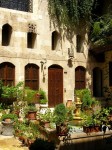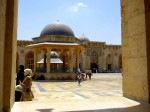Aleppo is the world’s oldest inhabited city or, at least, this is the claim made by its current inhabitants, in competition with those of Damascus and others in Far Eastern countries.
But it might well be possible. Aleppo comes from the Arabic word halab, milk. Tradition has it that it was in the fortress of Aleppo that Abraham rested on his way to Palestine, where he milked his flocks and distributed the milk amongst the needy. It has certainly been inhabited since the second millennium before Christ. It figures in the Hittite archives of Central Anatolia and in those of Mari (now Tell Hariri), the city on the Euphrates, an important point on trade routes that was inhabited by Akkadians and Sumerians, then by Hittites and, in 400 BC, by Assyrians and Persians. In 333 Aleppo was taken by Alexander the Great and then belonged to the Greek Empire under the Seleucid dynasty.
The venerable appearance and tranquillity of this city of olives, pistachios and cotton highlight its historic significance, not stifled even during the Socialist period in spite of the dilapidation of its dull central districts. The medina is a tight network of mostly Islamic monuments with, around it, an astonishing number of ancient sites and palaeo-Christian remains, such as Saint Simeon, which preserves the stone column on which the saint remained until forced to leave because of the large crowds who thronged to see him.
Later on, during the Crusades, Saladin undertook in Aleppo some of his most audacious feats, leading him to become Sultan of Egypt, Nubia, Cyrenaica, Yemen, Palestine and territories of Syria.
 The centre of Aleppo basically comprises residential areas, with good-quality housing, such as the one around the university hospital, and the commercial centre around the medina. The result is a dense, intact conglomerate of history reminiscent of a story by Ibn Batuta or Richard F. Burton. Absolutely the whole of the city, even the suburban districts, bears the colour of the limestone with which it is built, with no colours, nor tiles in the Turkish or Maghreb styles. Everything here is sober, even the way people dress. The dignified women, beautiful with pale skin and clear eyes, often wear a black chador.
The centre of Aleppo basically comprises residential areas, with good-quality housing, such as the one around the university hospital, and the commercial centre around the medina. The result is a dense, intact conglomerate of history reminiscent of a story by Ibn Batuta or Richard F. Burton. Absolutely the whole of the city, even the suburban districts, bears the colour of the limestone with which it is built, with no colours, nor tiles in the Turkish or Maghreb styles. Everything here is sober, even the way people dress. The dignified women, beautiful with pale skin and clear eyes, often wear a black chador.
Palaces and mansions
The city of milk’s monuments are outstanding and feature in all the standard tourist guides. But another way of visiting the city is by following the trail laid by its patios and gardens. Most of them are the typical Islamic walled gardens that keep themselves to themselves. Palaces, mansions, mosques and jans (caravanserais of Ottoman origin) open their doors only to those who seek peace in the shade of their patios. With architecture being an unequivocal feature, here in the Ayubí, Mameluke or Ottoman style, such patios are surrounded by galleries and watched over by a fountain or a pond ringed by carefully-tended domestic plants. Sometimes, as in those in the Bimaristan Arghan (a 14th century asylum), water and stone are the main protagonists, with beautiful fountains of different shapes and sizes, the aim being to cure the patients with the sound of water, affording them some respite from the cruel routine of their enclosed lives. A lesson in medieval anti-psychiatry.
 Also of great beauty are the patios in mansions, some of them now converted into restaurants or luxury hotels such as Mansuriya, from Ottoman times, in the medina, or others in the Christian district (30% of Aleppo’s inhabitants are Christian Armenians). In them, the families or their guests live their daily lives, in an exercise in what is now called, as if it were something new, intercultural co-existence.
Also of great beauty are the patios in mansions, some of them now converted into restaurants or luxury hotels such as Mansuriya, from Ottoman times, in the medina, or others in the Christian district (30% of Aleppo’s inhabitants are Christian Armenians). In them, the families or their guests live their daily lives, in an exercise in what is now called, as if it were something new, intercultural co-existence.
But the green lung of Aleppo is not in Islamic style. The Al Amma public park was built in the early 20th century during the French Protectorate. It is full of ponds and fountains, tall trees, cheerful flowerbeds and avenues brimming with people. MED-O-MED is currently working there to create a garden that will follow the Al-Andalus style with regard to landscaping, botany and teaching, in memory of the Hispanic-Syrian history that was shared over centuries.
Text and photographs: Inés Eléxpuru
This post is available in: English Español


